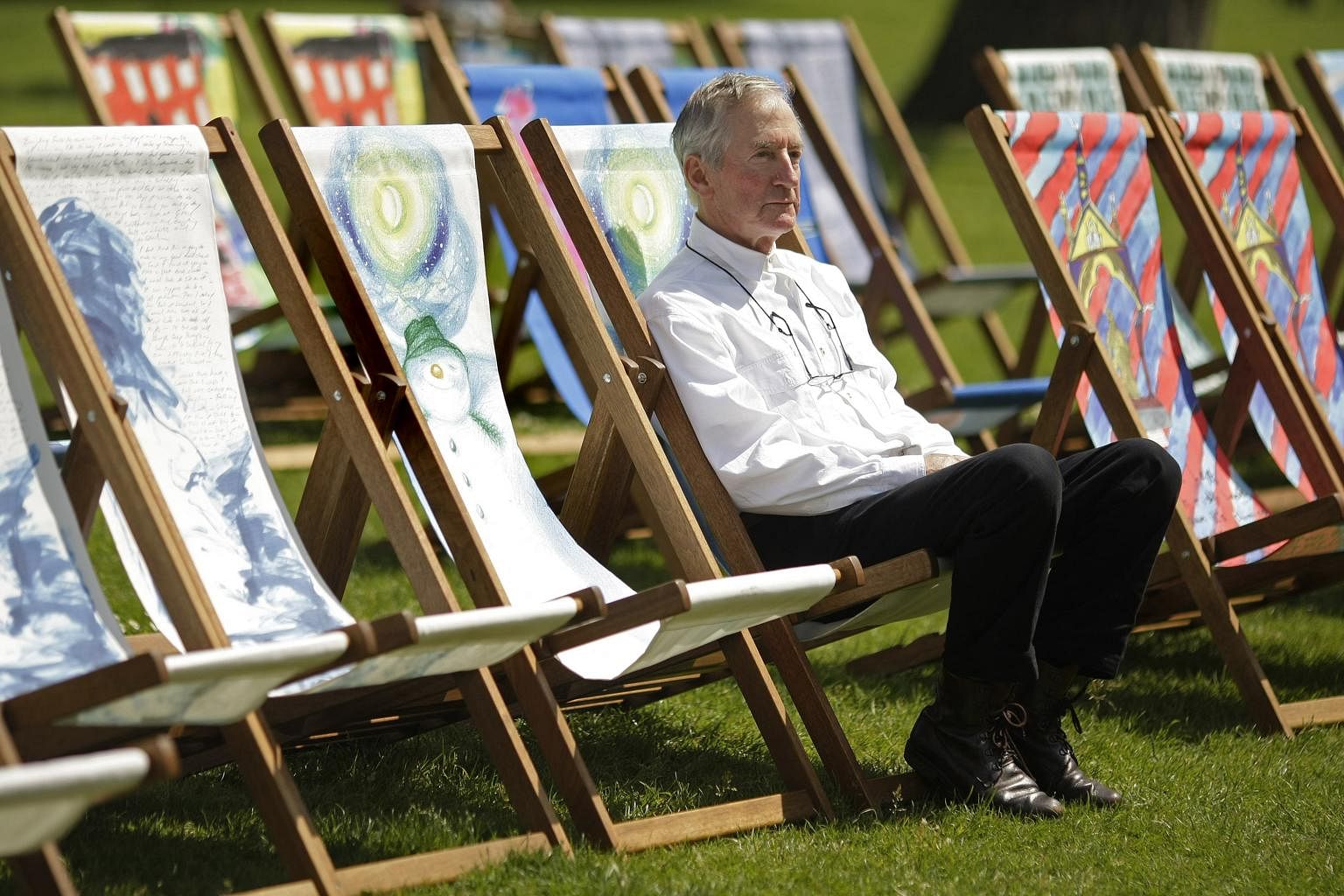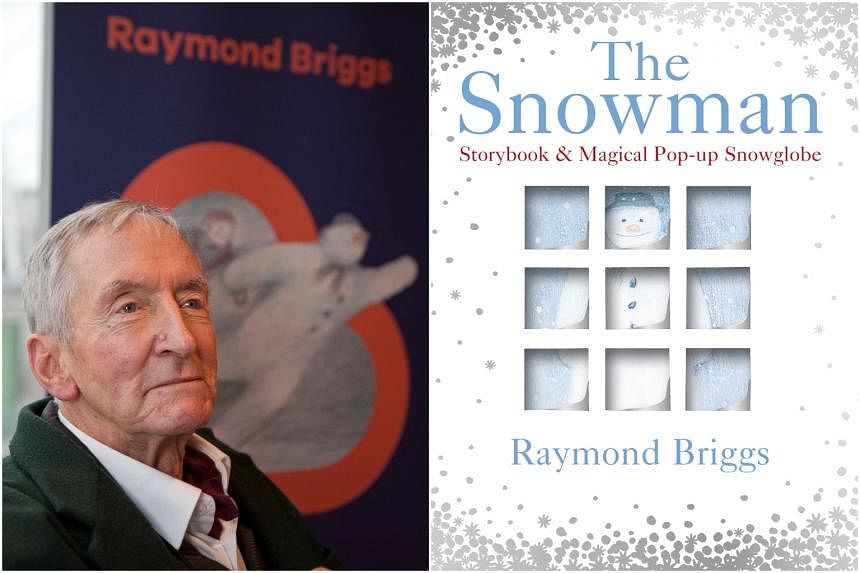NEW YORK (NYTIMES) - Raymond Briggs, the children's author whose cheeky illustrations dignified workaday British life and an audacious breadth of emotions, most prominently in the wordless escapades of The Snowman, died last Tuesday (Aug 9) in Brighton, England. He was 88.
By piling up square and rectangular frames like toy blocks, Briggs helped bring the visual language of comic books to children's stories.
The technique allowed him to cram action onto a page before delighting or shocking a reader with a large canvas - two new friends soaring over an English palace, or five warplanes ominously approaching.
Despite primarily gearing his work for children, some of his most successful books are meditations on death.
The Snowman (1978), which was adapted into one of England's most popular Christmas films, focuses on a fleeting friendship between a young boy and a snowman.
When The Wind Blows (1982), an argument for nuclear disarmament, shows a retired English couple blithely following the government's precautions before they are killed in a Soviet attack.
"I don't think about what children want," Briggs told the BBC in 2017. "You get an idea and you just do it."
Those offbeat ideas included Fungus The Bogeyman (1977), the title character a shy green creature whose long umbilical cord was censored by the publisher; The Man (1992), about a rude homunculus who vexes a boy; and Jim And The Beanstalk (1997), about a bald, farsighted giant's makeover.
Briggs often depicted domesticity and the routines of the working class.
In Gentleman Jim (1980), a toilet cleaner imagines what it would be like to have more fashionable careers; Ug: Boy Genius Of The Stone Age (2001) follows a young caveman whose parents think he should be content with drudgery instead of pursuing his ideas about fire and wheels.
Briggs admired the Northern Renaissance's emphasis on daily life - his studio wall included Children's Games by Flemish master Pieter Bruegel - but he was not interested in painting with oil.
After using sticky gouache for the grotesquerie of Fungus, he turned to coloured pencils to emphasise light in The Snowman.
He was meticulous about his backgrounds, drawing, for example, hundreds of bricks for a facade, and his squat, rounded humans often wondered whether there was more to life than toil; his approachable non-humans - giants were an early speciality - suggested that perhaps there was.
Yet failed aspirations and loss were consistent themes for Briggs, a melancholy soul.
In later years, he told interviewers that he had contemplated suicide after his wife, Jean, died from leukaemia in 1973, two years after he lost both of his parents.

In The Snowman - which, unlike Briggs' other books, has no words - rounded frames house the emotional arc of a boy's winter adventure.
The boy rejoices at a fresh snowfall, gleefully explores his home and country with a snowman who magically comes alive, and, in a crushing final panel, stares down at a green hat and scarf.
"The books are funny, and the books are also sad," Nicolette Jones, who wrote the biography Raymond Briggs (2020), said in an interview for this obituary earlier this year.
"And he walks this incredible tightrope between those two things."
A film adaptation of The Snowman, which was released in 1982 and features the haunting song Walking In The Air in its symphonic score, was nominated for the Academy Award for Best Animated Short Film.
Briggs briefly set the scene in the film's introduction, which was later rerecorded, to his chagrin, by David Bowie.
"He got it all wrong, terribly. Hopeless," Briggs told the BBC.
His frustrations extended to the brief appearance of Father Christmas in the film. On his pages, there is not a present in sight.
In his earlier book Father Christmas (1973), Briggs had depicted the gift-giver as an old man burdened by the frigid weather and his demanding work rather than as a jolly soul. His complaint "I hate winter!" was delivered on the toilet.
That irreverent wit was essential to When The Wind Blows, a satirical graphic novel published during the throes of the Cold War.
The book was adapted several times, including as a radio dramatisation and a West End play starring Patricia Routledge.
Before impending nuclear annihilation, a husband paints the windows white and builds a lean-to shelter while his wife frets about his staining the curtains and marking the wallpaper.
Frames upon frames of frantic preparations and idle chatter are interrupted by grey spreads of a missile or a submarine.
The blast itself fills two pages with white, plus tinges of pink.
After waving aside their symptoms - fever, loss of appetite, splotchy blue spots on their limbs - the couple succumb while struggling to remember a prayer.
Raymond Redvers Briggs was born in Wimbledon, London, on Jan 18, 1934, the only child of Ernest and Ethel (Bowyer) Briggs. His mother was a maid, his father a milkman. During World War II, he was briefly sent to live with his aunts in the countryside.
Growing up in a house without many books, he gravitated instead to the storytelling found in newspaper cartoons.
He studied at the Wimbledon School of Art as a teenager and, after spending two years as a draughtsman in the British army's Royal Corps of Signals, graduated from the Slade School of Fine Art in 1957.
After his wife's death, he spent four decades in a relationship with Liz Benjamin, who died of Parkinson's disease in 2015.
The Puddleman (2004) is dedicated to her three grandchildren, who survive him. He is also survived by a stepdaughter, Clare, and a stepson, Tom.
A book about his parents' long relationship and their traumatic deaths, Ethel And Ernest, was named the Illustrated Book of the Year in 1999 by the British Book Awards, which had declared Briggs its children's author of the year earlier that decade.
For his final published work, Time For Lights Out (2019), he mixed quotes, sketches and verse in the exploration of a theme that had enthralled him through life: the inevitability of death.

